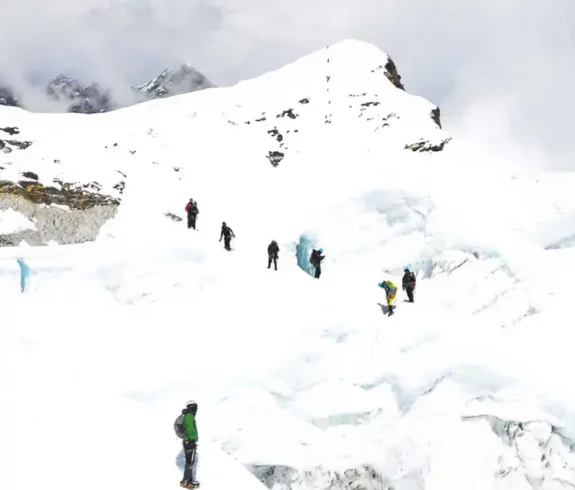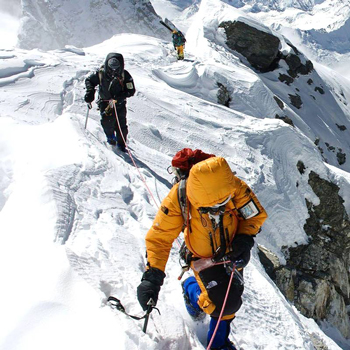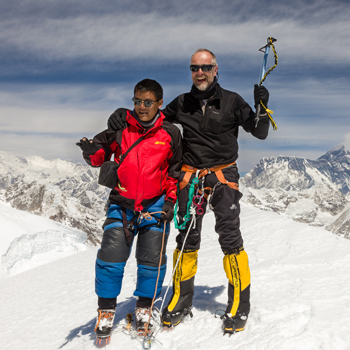Island Peak, also known as Imja Tse, is a prominent mountain in the Himalayas that attracts climbers worldwide. For those planning an expedition, understanding the “Island Peak Climbing Cost” is essential to budget effectively. This peak offers an attainable yet thrilling climbing experience, making it a sought-after destination for adventurers.
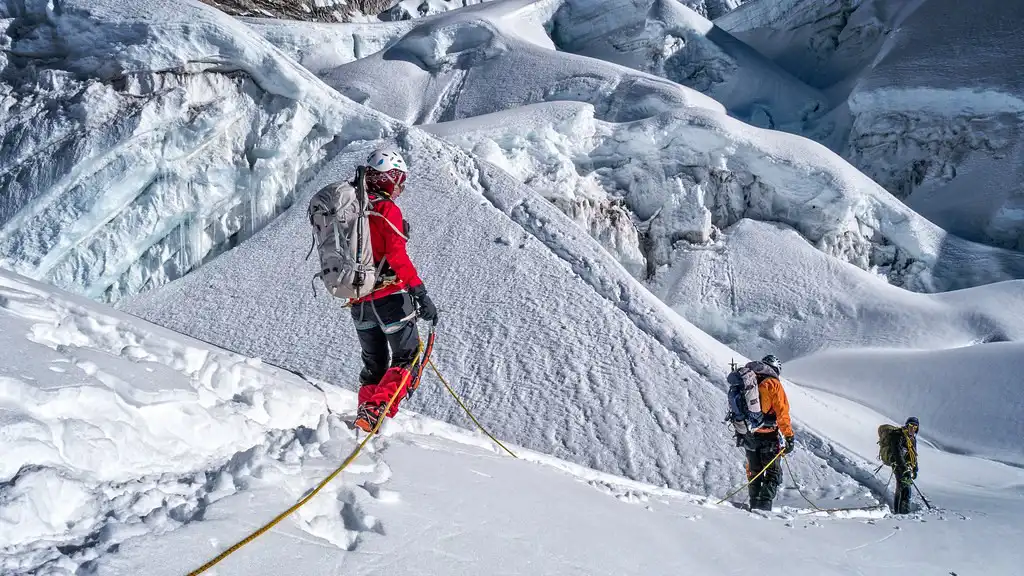
Island Peak is part of the Himalayas and rises to 6189 meters (20,305 ft) in height. It is located in the Sagarmatha National Park, a natural heritage site that UNESCO protects. One can see a range of vistas from the summit, which includes the high mountains such as Lhotse, Nuptse, and Ama Dablam.
Why Island Peak is a Popular Choice for High-Altitude Climbers
- Accessible for Beginners: The climb suits those new to high-altitude mountaineering, offering non-technical routes that still provide a challenging ascent.
- Stunning Scenery: Climbers are rewarded with breathtaking vistas of the Himalayas, including close-up views of Mount Everest and other iconic peaks.
- Cultural Richness: The trek to Island Peak passes through traditional Sherpa villages, allowing climbers to experience local culture and hospitality.
- Preparation for Higher Peaks: Many use Island Peak as a training climb for more demanding expeditions, making it a practical step for aspiring mountaineers.
- Well-Established Trekking Routes: The pathways are well-trodden and supported by local infrastructure, easing logistics for climbers.
- Relatively Affordable: Compared to other Himalayan expeditions, the costs, including the Island Peak permit cost, guide fees, and overall trek expenses, are more manageable, making it accessible to a broader range of climbers.
- Sense of Achievement: Reaching the summit provides a significant personal accomplishment without the extreme risks associated with higher altitudes.

Overview of Total Climbing Costs
In analyzing the Island Peak climbing cost, all other details are secondary to this individual’s comprehension of what the peak entails and the inner will to conquer this Himalayan peak. The entire cost comprises several items, including permits, payments to guides, trekking costs of equipment, and other miscellaneous costs. Being aware of such expenses from the outset assists in making appropriate estimates of their performance and helps manage the climbing activity.
Breakdown of Expenses
- Island Peak Permit Cost: Among the necessary steps, climbers usually apply for and obtain climbing permits. The Island Peak permit cost also has seasons; the fee increases to a brilliant rate during the climbing season.
- Island Peak Guide Fees: Working with a certified guide improves safety and boosts your chances of a successful summit. The Island Peak guide fees depend on the guide’s experience and the length of the expedition.
- Island Peak Trek Expenses: Reaching the base camp involves trekking through the Everest region, which incurs costs for accommodation, meals, and local transportation. These Island Peak trek expenses can vary based on the level of comfort and services chosen.
- Equipment Costs: Specialized gear is necessary for the climb. Renting equipment can reduce expenses compared to purchasing new items.
- Miscellaneous Expenses: Other expenses include travel insurance, visa application costs, gratuities for the guides and porters, and personal expenses like food and foreign goods.
Importance of Budgeting and Planning Ahead
Budgeting and planning ahead are essential if one intends to go for a successful climb. If all the possible expenses are accounted for and itemized, the climbers can eliminate the surprise costs likely to interfere with their plans.
Planning early, for instance, enables one to obtain the necessary permits quickly and even book the preferred guides and lodges, often at lower prices. It also allows time to source the best equipment bargains or organize to acquire good quality and affordable rentals, thus controlling the entire cost.

Island Peak Permit Cost
Understanding the required permits is crucial when planning your Island Peak Climbing Cost. Permit fees form a significant part of the total budget, alongside guide fees and trekking expenses.
Climbing Permit Fees
To summit Island Peak, climbers must obtain a climbing permit. The Island Peak permit cost varies depending on the season:
- Spring (March to May) and Autumn (September to November): The permit fee is approximately USD 250 per person during these peak climbing seasons.
- Winter (December to February) and Summer (June to August): The fee is reduced to around USD 125 per person in the off-peak seasons.
These seasonal variations reflect the demand and favorable climbing conditions at different times of the year. As fees can change, verifying the latest rates with the Nepal Mountaineering Association or a reputable trekking agency is advisable.
Sagarmatha National Park Entry Permit
An entry permit for Sagarmatha National Park is also required:
- Cost: Around NPR 3,000 (about USD 30) for international visitors.
- Where to Obtain: You can get this permit from the Nepal Tourism Board office in Kathmandu or at the park entrance in Monjo.
This fee supports conservation efforts and the maintenance of the park’s facilities.
Trekkers’ Information Management System (TIMS) Card
The Trekkers’ Information Management System (TIMS) Card is mandatory for all trekkers in Nepal:
- Fee: Approximately NPR 2,000 (around USD 20) for individual trekkers.
- Purpose: The TIMS Card records trekkers’ information for safety and security purposes.
- Where to Obtain: Available at the Nepal Tourism Board offices or through authorized trekking agencies.
Island Peak Guide Fees
Guide fees are a significant component when calculating the Island Peak Climbing Cost. Hiring experienced professionals enhances safety and increases the likelihood of a successful summit.
Hiring a Certified Guide
Working with a licensed guide is essential for navigating the challenging terrain of Island Peak.
- Importance of a Licensed Guide: Certified guides have the expertise and experience to lead climbers safely. They are trained in high-altitude climbing, first aid, and emergency procedures.
- Average Daily Rates for Guides: The Island Peak guide fees typically range from USD 25 to USD 30 daily, but this rate may vary based on the guide’s experience and expertise.
Porter Fees
Porters can be hired to carry equipment and supplies, easing the physical burden on climbers.
- Cost of Hiring Porters: Porter fees average around USD 15 to USD 20 per day. Hiring porters allows climbers to conserve energy for the ascent.
Agency vs. Independent Guides
Deciding between booking through a trekking agency or hiring an independent guide affects both cost and convenience.
- Agency Guides: Trekking agencies offer comprehensive packages that include guides, porters, permits, and logistics. While more expensive, they handle all arrangements.
- Independent Guides: Hiring independently can lower the Island Peak Climbing Cost but requires more effort in planning and verifying credentials. Also, to get the permit to Island Peak, you must join a trekking company like Peregrine Treks and Expedition.
Cost Differences
- Agency Packages: Typically range from USD 2,500 to USD 4,000, covering most Island Peak trek expenses.
- Independent Arrangements: This climbing can’t be done independently.
Group Discounts
Climbing with a group offers potential savings on overall expenses.
- Potential Savings: Shared costs for guides and porters lower individual expenses.
- Benefits: Group rates on accommodations and permits can further reduce the Island Peak Climbing Cost.
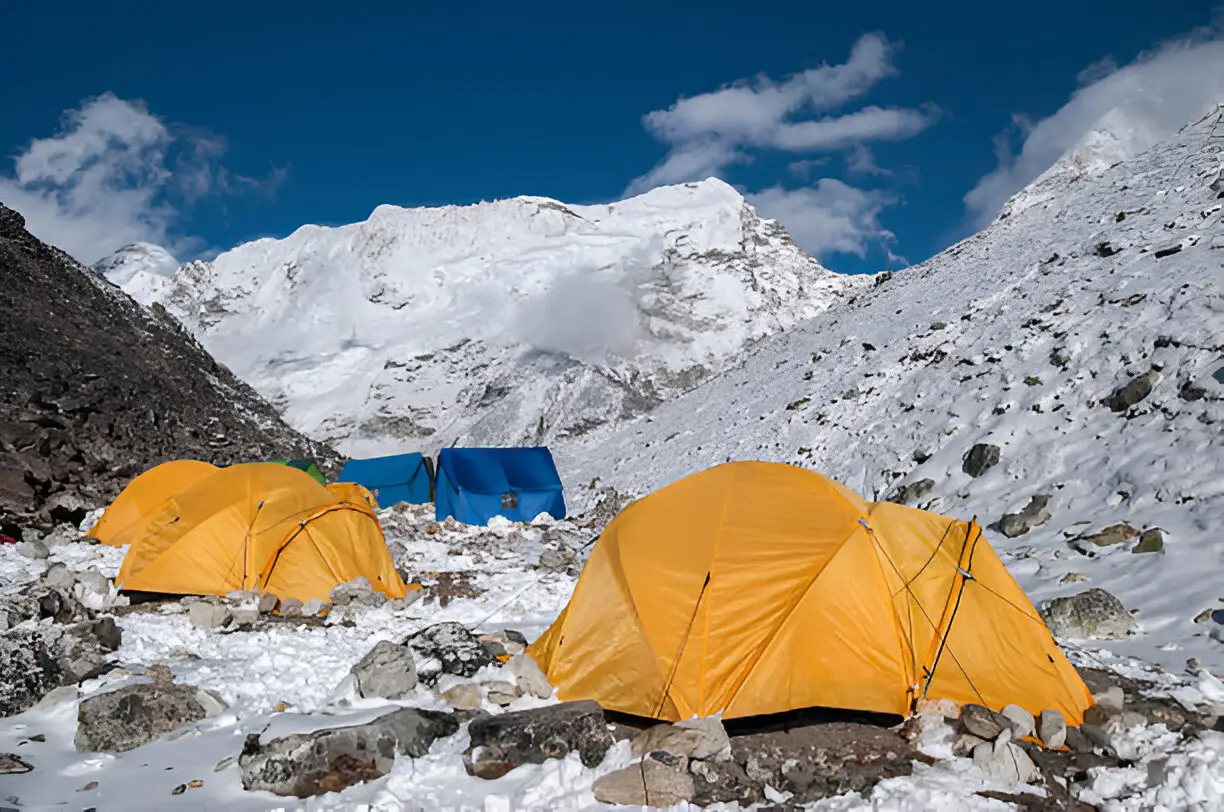
Island Peak Trek Expenses
When planning the Island Peak Climbing Cost, it’s crucial to consider various trek expenses that will arise during the expedition. These costs include accommodation, food and drinks, transportation, equipment rental or purchase, and miscellaneous expenses. Proper budgeting ensures a smooth and enjoyable climbing experience.
Accommodation Costs
Accommodation along the trekking route primarily consists of teahouses and lodges. Prices vary based on altitude and amenities.
Teahouses and Lodges Prices
- Lower Elevations: Expect to pay around USD 5 to USD 10 per night.
- Higher Elevations: Prices can increase from USD 15 to USD 20 per night due to the difficulty of transporting goods to these areas.
These accommodations provide basic facilities, including a bed and shared bathroom. Some may offer additional services at extra costs.
Food and Drinks
Meals are a significant part of the Island Peak trek expenses. As you ascend, the cost of food and beverages increases.
Daily Meal Expenses: Budget approximately USD 25 to USD 35 per day for three meals and hot drinks.
Cost Variations at Different Altitudes
- Lower Elevations: Meals may cost USD 5 to USD 7 each.
- Higher Elevations: Prices can rise from USD 10 to USD 15 per meal.
The increase in cost is due to the logistical challenges of transporting food to higher altitudes.
Transportation Costs
Transportation plays a crucial role in the total cost of Island Peak Climbing.
- Flights to and from Lukla: The most common route is a flight from Kathmandu to Lukla, which costs about USD 180 one way or USD 360 round trip.
- Local Transportation Fees: Alternatives include bus or jeep rides to trailheads like Jiri or Salleri, which cost between USD 20 and USD 30, but this extends the trekking duration.
Booking is recommended to secure seats and get better rates, especially during peak seasons.
Equipment Rental or Purchase
Climbing Island Peak requires specialized equipment. Renting can be more economical than purchasing.
- Costs for Renting Climbing Gear: Items like crampons, ice axes, harnesses, and boots can be rented for about USD 150 to USD 200 for the entire trek.
- Purchasing Equipment: Buying new gear can cost upwards of USD 1,000, depending on the brand and quality.
Ensure that rented equipment is in good condition and fits properly to avoid issues during the climb.
Miscellaneous Expenses
Additional expenses can add up, so allocating funds for them is wise.
- Charging Electronics: Costs USD 2 to USD 5 per hour to charge devices at teahouses.
- Wi-Fi Access: Internet services are available at some locations for USD 5 to USD 10 per hour.
- Hot Showers: A hot shower can cost between USD 5 and USD 8, especially at higher altitudes.
- Drinking Water: Bottled water costs USD 1 at lower elevations and up to USD 4 higher. Using water purification tablets is a cost-effective alternative.
- Snacks and Beverages: Extra treats like chocolate bars or soft drinks range from USD 2 to USD 5.
Insurance and Emergency Costs
When calculating the Island Peak Climbing Cost, insurance and emergency expenses are essential factors to consider. Adequate travel and climbing insurance safeguard against unforeseen events, ensuring peace of mind during your expedition.
Travel and Climbing Insurance
Having comprehensive travel and climbing insurance is crucial for anyone attempting Island Peak.
Importance and Estimated Costs: Climbing at high altitudes involves inherent risks. Insurance offers financial coverage for accidents, illnesses, and trip disruptions. Such insurance costs range from USD 150 to USD 300, depending on the coverage and duration.
Coverage Details to Look For
- High-Altitude Evacuation: Ensure the policy covers emergency evacuation up to at least 6,500 meters, which exceeds Island Peak’s altitude.
- Medical Expenses: Coverage for medical treatments and hospitalizations in Nepal.
- Trip Cancellation and Interruption: Protection against losses due to unforeseen cancellations.
- Baggage and Equipment Loss: Reimbursement for lost or damaged gear can impact the overall Island Peak Climbing Cost.
- Adventure Activities Clause: Confirm that mountaineering activities are included, as standard policies may exclude them.
Selecting the right insurance policy helps manage unexpected Island Peak trek expenses, keeping your budget intact.
Emergency Evacuation
In emergencies, swift evacuation is critical but costly if not covered by insurance.
Potential Costs if Not Covered by Insurance
- Helicopter Evacuation: Costs can exceed USD 5,000 for airlifting from remote locations like Island Peak.
- Medical Treatment: Without insurance, hospital bills can add significantly to your Island Peak Climbing Cost.
- Repatriation: Arranging transport back to your home country in case of serious injury can be extremely expensive.
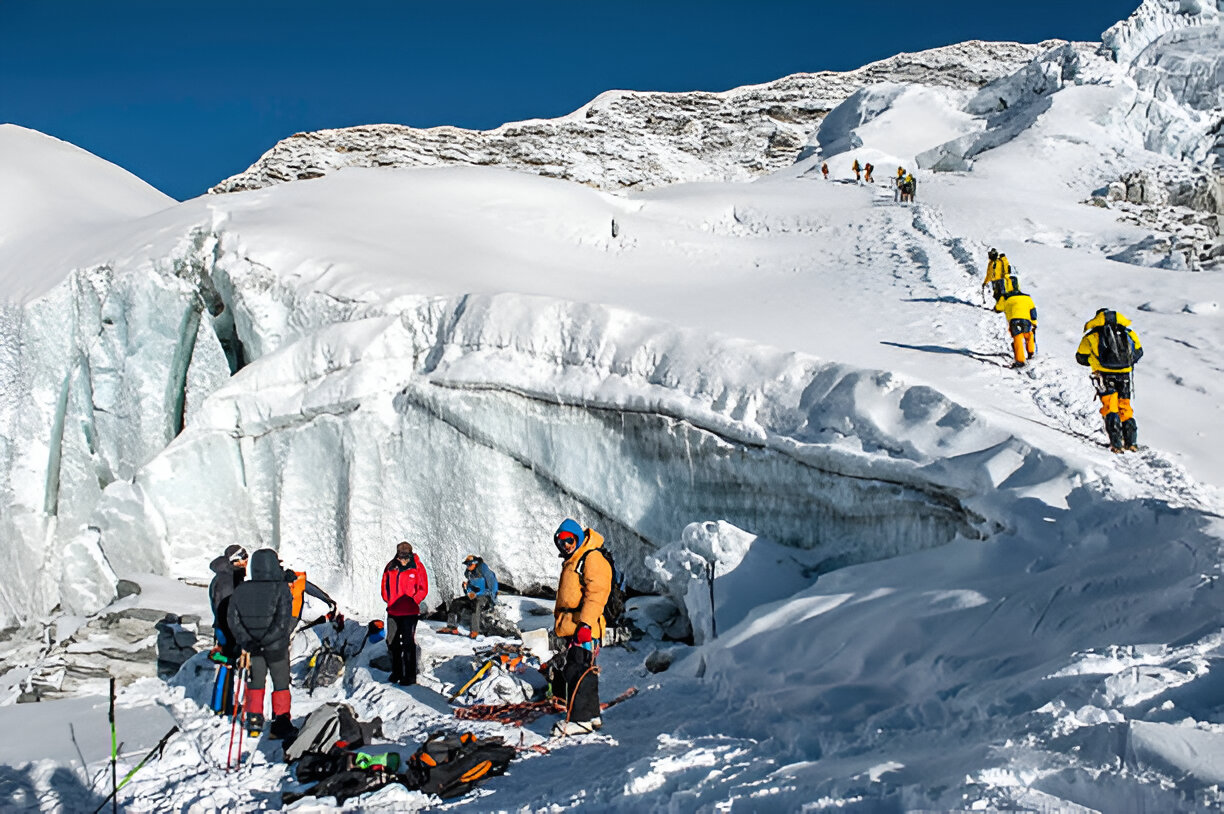
Additional Expenses
When determining the total cost of Island Peak Climbing, it is essential to consider other expenses that may not be immediately obvious and take time to calculate them. These expenses can significantly affect your overall financial plan.
Visa Fees
Before entering Nepal, travelers must obtain a Nepalese visa.
Cost of Obtaining a Nepalese Visa
- On Arrival: A 30-day tourist visa costs USD 50, while a 90-day visa is USD 125.
- Multiple Entries: If you plan to exit and re-enter Nepal, ensure your visa allows multiple entries, which may incur additional fees.
Where to Get It: Visas are available on arrival at Tribhuvan International Airport in Kathmandu and at various land border crossings.
Including visa fees in your budget helps avoid unexpected expenses upon arrival.
Vaccinations and Medical Prep
Health preparation is crucial for a successful climb.
Possible Medical Expenses Before the Trip
- Vaccinations: Recommended vaccines include Hepatitis A and B, Typhoid, Tetanus, and Rabies. Costs vary but can range from USD 100 to USD 300, depending on your location and insurance coverage.
- Medical Check-ups: A pre-trip medical examination might cost between USD 50 and USD 200.
- Medications: Altitude sickness medication like Diamox may add to your expenses.
Allocating funds for medical preparation ensures you’re physically ready for the challenges ahead.
Tips and Gratuities
Tipping is customary in Nepal and appreciated by those who assist you.
Standard Tipping Practices for Guides and Porters:
- Guides: Consider tipping your guide USD 10 to USD 15 per day.
- Porters: A tip of USD 5 to USD 10 per day is standard for porters.
- Group Tips: If you’re part of a group, pooling tips is standard practice.
Including tips in your Island Peak Climbing Cost shows gratitude for the hard work of your support team.
Personal Expenses
Personal spending can vary but should be anticipated.
- Souvenirs: Handmade crafts, clothing, and other mementos can cost from USD 5 to USD 50 each.
- Extra Snacks and Beverages: Cravings for chocolate bars, energy drinks, or alcoholic beverages can increase as prices rise significantly with altitude.
- Entertainment: Expenses for books, movies, or local cultural experiences might also arise.
Budgeting for personal expenses ensures you can enjoy extras without straining your finances.

Cost Variations
The total Island Peak Climbing Cost can fluctuate due to several factors. Being aware of these variations helps in accurate budgeting.
Seasonal Price Changes
Costs can differ between peak and off-peak seasons.
How Peak and Off-Peak Seasons Affect Costs:
- Peak Seasons (Spring and Autumn): Higher demand leads to increased prices for accommodation, flights, and Island Peak guide fees.
- Off-Peak Seasons (Winter and Monsoon): Lower demand may result in discounted rates, but weather conditions are more challenging.
Permit Fees: The Island Peak permit cost is lower during off-peak seasons, affecting overall expenses.
Choosing the right season can influence both your budget and climbing experience.
Currency Fluctuations
Exchange rates can impact your spending power.
Impact of Exchange Rates on Your Budget
- Currency Strength: Fluctuations between your home currency and the Nepalese Rupee or US Dollar can affect the cost of services and goods.
- Monitoring Rates: Keeping an eye on exchange rates allows you to convert money when rates are favorable.
Accounting for currency fluctuations helps maintain control over your Island Peak trek expenses.
Economic Factors
Local economic conditions in Nepal can influence prices.
How Local Economic Conditions Might Influence Prices
- Inflation: Rising living costs can increase food, accommodation, and services prices.
- Government Policies: Changes in tourism regulations or taxes can affect permit fees and other charges.
- Fuel Prices: Increases can lead to higher transportation and logistics costs, which can impact the overall cost of climbing Island Peak.
Cost-Saving Tips
Reducing the Island Peak Climbing Cost without compromising the experience is possible with strategic planning. Here are practical tips to help you save money.
Booking in Advance
- Early Reservations Lower Costs: Skillfully booking flights, accommodations, and guides in advance can secure better rates. Airlines and lodges often offer discounts for early bookings, reducing your overall Island Peak trek expenses.
Group Discounts
- Benefits of Joining a Group Trek: Trekking allows you to share costs for guides and porters. Group rates for accommodations and permits can also lower expenses. This collaborative approach significantly reduces individual costs, including the Island Peak guide fees.
Negotiating Prices
- Bargaining with Local Providers: In Nepal, negotiating is standard practice. You can often negotiate better rates for accommodations, equipment rentals, and even guide services. Polite and respectful bargaining can yield substantial savings on your Island Peak Climbing Cost.
Off-Peak Travel
Advantages of Climbing During Shoulder Seasons: Traveling during off-peak seasons like winter or monsoon can lower costs. Permit fees are reduced, and accommodations may offer discounts due to lower demand. However, be prepared for challenging weather conditions that may affect your climb.
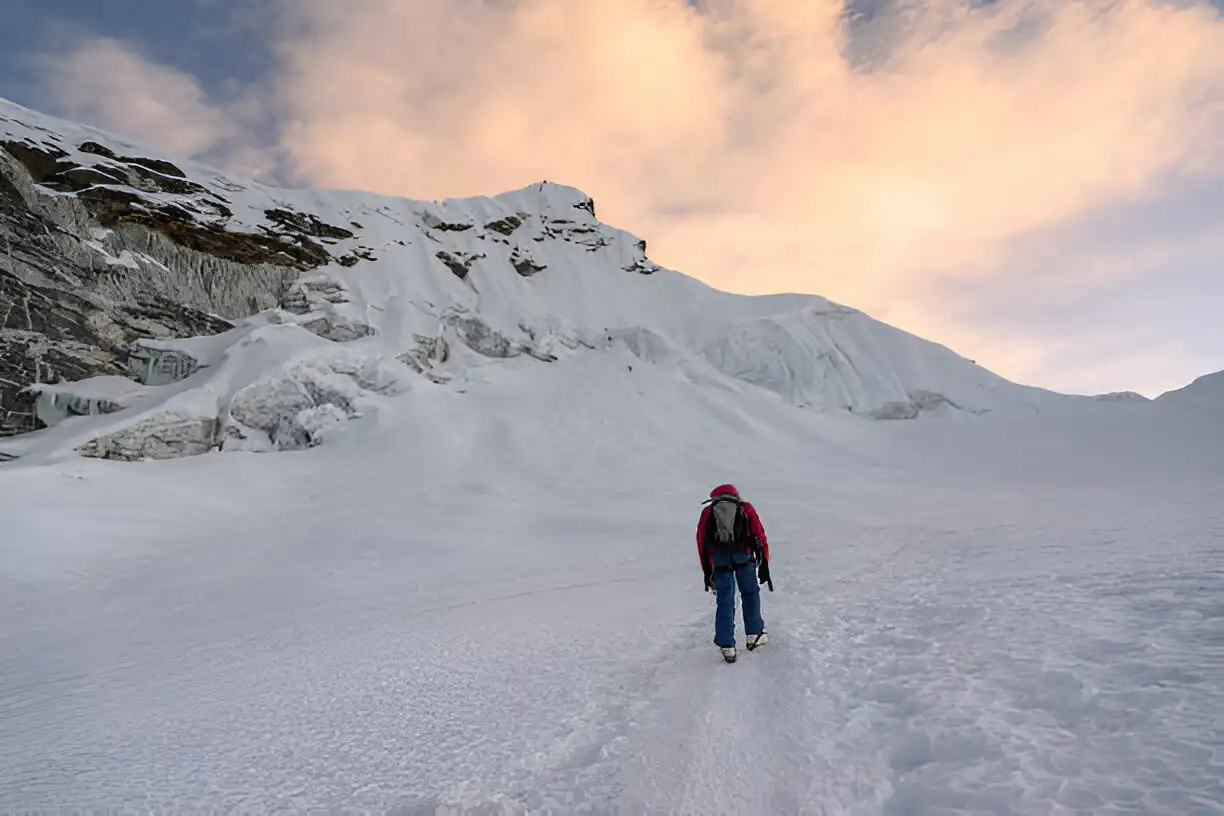
Best Time to Climb and Its Impact on Island Peak Climbing Cost
Choosing the right season to tackle Island Peak dramatically enhances your experience and significantly influences the Island Peak Climbing Cost. Optimal times for this climb are the pre-monsoon (spring) period from March to May and the post-monsoon (autumn) months from September to November.
Ideal Seasons for Climbing Island Peak
- Spring (March to May): Enjoy stable weather and clear skies for excellent climbing conditions. The vibrant blooming rhododendrons along the trek paths add color to your adventure.
- Autumn (September to November): After the monsoons, the air clears, offering crisp, unobstructed views of the mountain landscapes. This season is favored for its mild temperatures and minimal rainfall.
Impact of Timing on Permit Costs and Availability
Your choice of season affects both the Island Peak guide fees and its availability:
- Peak Season Demand: Permit applications surge in the spring and autumn. Apply early to secure your necessary permits.
- Fluctuating Permit Fees: Although Island Peak permit costs typically stay steady, some agencies might offer discounts in the less crowded off-peak seasons.
Weather Considerations and Their Financial Impact
Weather conditions are a critical consideration as they directly affect your budget planning:
- Stable Weather Minimizes Delays: Good weather in peak seasons helps avoid unexpected delays, which can otherwise increase your Island Peak trek expenses on additional food and lodging.
- Challenges of Off-Peak Climbing: Winter and monsoon climbs pose risks with heavy snow and rain, possibly necessitating extra gear and potentially higher Island Peak guide fees due to extended trek durations.
- Investment in Quality Gear: Poor weather might require higher-quality equipment, impacting your overall Island Peak Climbing Cost.
Preparation and Training Costs
Adequate preparation is essential for a successful ascent, significantly contributing to your Island Peak Climbing Cost.
Physical Training Costs
Proper fitness is crucial:
- Gym Memberships: Securing a gym membership to enhance strength and endurance might cost you between USD 30 and USD 100 monthly.
- Specialized Training Programs: For USD 200 to USD 500, you can enroll in mountaineering courses or hire a personal trainer.
- Outdoor Activities: Though membership fees may apply, join hiking or climbing clubs to gain practical experience.
Investing in your physical preparation can reduce risks and unexpected costs during your climb.
Equipment Purchase Expenses
Personal climbing gear ensures safety and comfort:
- Mountaineering Boots: Invest in high-quality boots for USD 200 to USD 500.
- Climbing Apparel: Purchase suitable layered clothing for high altitudes, which may cost between USD 300 and USD 600.
- Accessories: You should budget between USD 100 and USD 200 for essential accessories such as gloves, hats, and sunglasses.
- Technical Equipment: While some gear is rentable, buying personal items like harnesses or helmets ensures a proper fit. These typically cost USD 150 to USD 300.
Environmental and Conservation Fees
When planning your expedition, remember to account for environmental and conservation fees that help preserve the natural beauty of the Everest region. These additional costs are crucial in maintaining the ecosystem and supporting sustainable tourism.
Additional Fees Contributing to Conservation
- Garbage Deposit Fee: The Nepalese government requires a refundable garbage deposit of USD 500 per group. This fee ensures that climbers bring back their waste, helping to keep the mountain clean.
- Community Development Fees: Some local communities may charge a small fee, usually between USD 10 and USD 20, which goes toward local infrastructure and community projects.
Including these fees in your Island Peak Climbing Cost complies with regulations and supports environmental conservation efforts.
Importance of Supporting Sustainable Tourism
Supporting sustainable tourism is vital for the long-term preservation of the Himalayas. By paying these fees, you contribute to:
- Environmental Protection: Funds are used for conservation projects that protect the fragile mountain environment.
- Local Communities: Your contributions aid in developing regional communities and improving their livelihoods.
- Future Trekking Opportunities: Sustainable practices ensure that Island Peak remains accessible and pristine for future climbers.
Conclusion
Thorough budgeting is essential when planning your climb. Understanding all aspects of the Island Peak Climbing Cost, including permit fees, guide fees, trek expenses, and conservation fees, prepares you financially for this adventure.
Climbing responsibly and being well-prepared increases your chances of a successful summit and supports the environment and local communities. Plan, train adequately and respect your natural surroundings to maximize your climbing.
